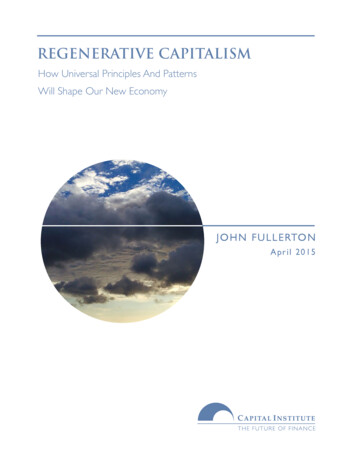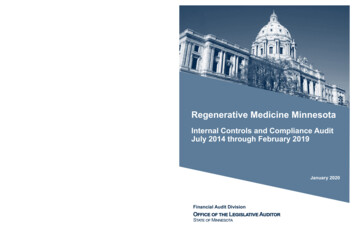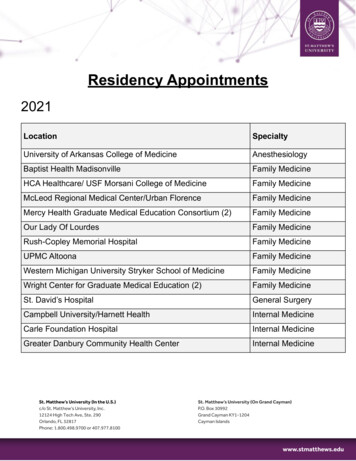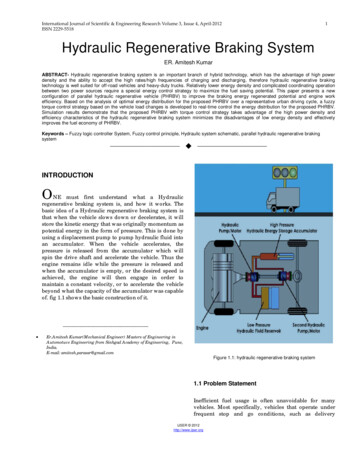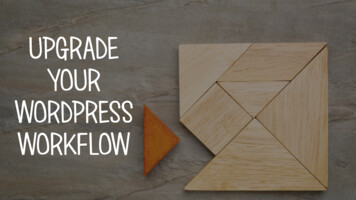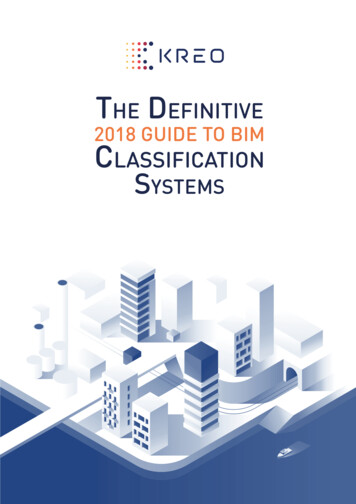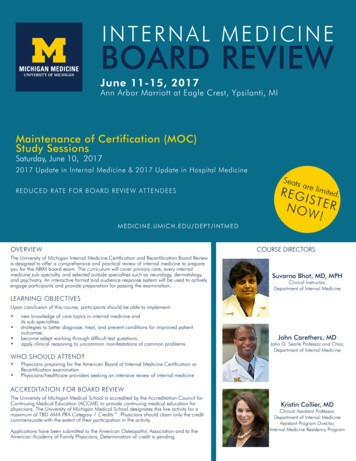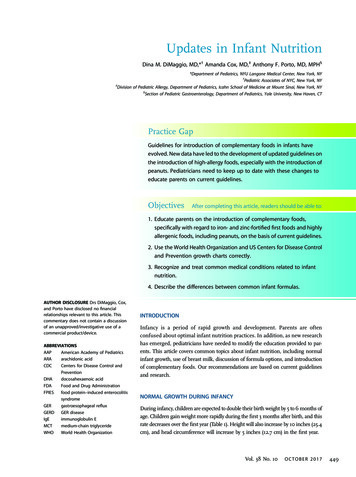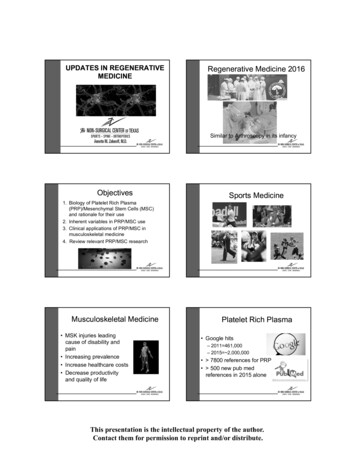
Transcription
UPDATES IN REGENERATIVEMEDICINERegenerative Medicine 2016Similar to Arthroscopy in its infancyObjectivesSports Medicine1. Biology of Platelet Rich Plasma(PRP)/Mesenchymal Stem Cells (MSC)and rationale for their use2. Inherent variables in PRP/MSC use3. Clinical applications of PRP/MSC inmusculoskeletal medicine4. Review relevant PRP/MSC researchMusculoskeletal Medicine MSK injuries leadingcause of disability andpain Increasing prevalence Increase healthcare costs Decrease productivityand quality of lifePlatelet Rich Plasma Google hits– 2011 461,000– 2015 2,000,000 7800 references for PRP 500 new pub medreferences in 2015 aloneThis presentation is the intellectual property of the author.Contact them for permission to reprint and/or distribute.
Regenerative MedicineNew Musculoskeletal Regeneration Program‐ pipeline frombiomedical discovery to clinical implementationMesenchymal Stem Cells BMAC 5-6x increase vs Adipose Trophic Effects (Drugstore?)– Cytokines, chemokines, GF– Angiogenesis, mitosis, antiscarring, anti-apoptotic Local ModulationRegenerative medicine has been called the "next evolution ofmedical treatments," by the U.S. Department of Health and HumanServices. With its potential to heal, this new field of science isexpected to revolutionize health care.– Anti-inflammatory– Immunomodulatory– Anti-microbialNo Quick em Cell DifferentiationPlatelet Rich PlasmaWhy Is the LiteratureConfusing? 4x baseline concentrations Growth factors– Cell proliferation, tissuegrowth Cytokines– Intercellular interactions Chemokines– Attract stem cells andmacrophages PRP-Stem Cell variables Biology of healing Micro-environment ofinjury site What’s the realdiagnosis?– Effects of biotensegrityand biomechanicaldisruptionsThis presentation is the intellectual property of the author.Contact them for permission to reprint and/or distribute.
PRP VariablesThe PRP-Stem Cell VariablesHarvest Patient Equipment / Processing Cell countsBiomet GPS– PRP, MSC– RBC, WBC’s /– Dose, FrequencyArteriocyte Activation / Other medicationsThe VariablesThe PatientAm J Sports Med. 2011 Feb;39(2):266-71.PRP VariablesCorticosteroids and AnestheticsPatient Platelet CountPatient A150 x 103Patient B350 x 103PRP System 2X 300,000PRP System 2X 700,000PRP System 5X 750,000PRP System 5X 1,750,000PRP ONLYCONTROLSPRP CSThis presentation is the intellectual property of the author.Contact them for permission to reprint and/or distribute.
The Biologic Variables Microenvironment / healing response– Tendinopathy: degenerative, ineffectivehealing cascade– Osteoarthritis: increased catabolicactivity, subchondral bone and cartilageinjury– Mechanism: Conductor vs Orchestra Do all tissues respond the same totreatment?Customize Formulations forSpecific Indications Indications– Pro- or anti-inflammatory– Target: tendinopathy, OAjoint, Subchondral bone?– Acute injuries Cells and Bioactive Factors Activation Dose, frequencyPRP ClassificationWBC’sActivationType 1[Increased]NoType 2[Increased]YesType 3Minimal to noneNoType 4Minimal to noneYesType A: 5x [Platelets]Type B: 5x [Platelets]PRP type is likely to affect tissue healing differently.Other Variables Patient– Immune system– Lifestyle/Nutrition issues Rehabilitation methods Biotensegrity– Soft tissue integrity– Bone/joint integrity– Biomechanical integrityMechanical Treatment Goals Muscular/Myofascial Neural– Hydrodissection Tendon– Peri- or Intra-tendinous– Enthesis Joint– Intra-articular– Intra-osseous– Peri-articularIndications for PRP and MSC’s Any chronic tendon, ligament orjoint injury with pain– Accessible to injection therapy– failed appropriate conservativemanagement– Patient is not interested, poorcandidate for surgery Subacute / chronic muscle injuries Facilitate healing post-opThis presentation is the intellectual property of the author.Contact them for permission to reprint and/or distribute.
PRP StudiesPRP and MSC TreatmentsKnee OA: PRP vs HA– Arthroscopy 2011-Kon et al; PRP vs HA: KneeOA– AJSM 2012-Cerza, F.et al; Comparison betweenHA and PRP for knee OA– Am J of PMR 2012-Spakova, T. et al;Autologous PRP vs HA treatment for knee OA– Arthroscopy 2012-Sanchez, M. et al; RCTevaluating plasma rich in GF’s vs HA in knee OA– AJSM 2013-Patel/Dhillion; PRP vs saline: KneeOA– Clin Med Insights Arthritis Musculoskelet Disord.2015-Raeissadat S.A.et al; Knee OA Injection:PRP vs HA, One year RCT Common conditions treated– Tendons, ligaments, joints Cost Post-injection care Adverse reactions– High safety profileSummary: PRP / MSC Studies Tendinopathies– Yes– Shoulder, elbow, hip,knee, ankle, foot Knee, ankle OA,cartilage damage– Getting stronger Hip OA– Working on itPRP vs Standard of Care PRP vs cortisone– AJSM 2010-Gosens et al;PRP vs cortisone:Chronic lateralepicondylitis, RCT– Foot Ankle Int. 2014Monto RR. PRP vscortisone: Chronic plantarfasciitisPRP and Stem Cell Studies Lateral epicondylosisRotator cuff tendinosisPatellar tendinosisAchilles tendinosisPlantar fasciosisKnee and Hip OALumbar disc diseaseNon-union of long bonesMSC Clinical Trials in U.S.July 2015Bone Marrow vs. AdiposeStem Cells Pain and donor sitemorbidities Cell number and activitywith aging, quantity MSC yield (NC/G)– Bone marrow: 30,000– Adipose: 1,000,000 (500 X) FDA regulationThis presentation is the intellectual property of the author.Contact them for permission to reprint and/or distribute.
Stem Cell Research Hernigou P, et al: Biologic augmentation ofrotator cuff repair with mesenchymal stemcells during arthroscopy improves healing andprevents further tears: A case-controlled study.Int Orthop 2014;38(9):1811-1818. Vangsness CT Jr,et al: Adult humanmesenchymal stem cell intra-articular injectionfollowing partial medial meniscectomy: Arandomized, double-blind, controlled study. JBone Joint Surg Am 2014;96(2):90-98.Stem Cell Studies MRI comparison of control scaffold, PRPand BMAC treatment for cartilagedefects– BMAC PRP Control– AJSM PreView, Nov 16, 2015; Krych, A.PRP Stem Cells ADSC w/ PRP s/p AKS– 87% maintained or improvedcartilage status w/ 2nd lookarthroscopy at 2 years– Knee Surg Sport Trauma, 2013Koh et alWhere are We Headed? What we know What we don’tknowPRP MSC’s PRP MSC Synergy– Enhances stem celland fibroblastproliferation– Inflammation– Anti-microbial– AngiogenicThank youwww.drZmd.comamzsportsmd@msn.comThis presentation is the intellectual property of the author.Contact them for permission to reprint and/or distribute.
Stimulate Healing ResponseTendon and Ligament HealingRat Model:– 8-10 days: Inflammatory phase is evident– 1-12 weeks: Collagen synthesis, crosslinking– 8 weeks: Collagen begins to alignlongitudinally– 3 weeks – 1 year: Collagen remodeling(Greenley TK, 1971)There is no “quick fix” for tendon healingStem Cell DifferentiationUse of Corticosteroids andAnestheticsArthroscopy. 2012 May;28(5):711-9.Human tenocytes cultured in PRP alone,or in combination with corticosteroidsand/or anesthetics (lidocaine,bupivacaine)This presentation is the intellectual property of the author.Contact them for permission to reprint and/or distribute.
Biologic Treatment GoalsDisruption of Biotensegrity Tendinopathy– Degenerative tissue withineffective healing cascade Osteoarthritis– Increased catabolic activity,subchondral bone injury,cartilage destruction Pro- or Antiinflammatory PRP?Disruption of BiotensegrityMechanical Treatment Goals Tendon– Peri- or Intra-tendinous– Entheseal Joint– Intra-articular– Intra-osseous– Peri-articular Muscular/Myofascial Neural– HydrodissectionDisruption of BiotensegrityCommon Conditions Treated Tendon, Ligaments, Muscles– Tendinosis/partial tears, Rotator cuff, Tennis elbow, Patellar,Achilles, Peroneal, Plantar fasciosis– Knee MCL / LCL sprain, Elbow UCLsprain– Chronic muscle strain injuries OA– Hip, Knee, AnkleThis presentation is the intellectual property of the author.Contact them for permission to reprint and/or distribute.
PRP and MSC Treatments Common conditions treated– Tendons, ligaments, joints Cost Post-injection care Adverse reactions– High safety profilePRP Cost 1000- 2000 with/without U/Sguidance– Kits cost 250, Facility, Professionalcharges Coding: PRP CPT Code 0232T Not universally covered by insurers– Prior authorization process in place– Worker’s Compensation viewsfavorably in some statesPRP Post-injection Care: Brief (72 hr) period of immobilization/protection, early AROM Avoid NSAIDs x 2 weeks– Ice, Acetaminophen o.k. Begin progressive PT programwithin 2 weeks of injection Low intensity tendon loading for first6-8 weeks, then activity as toleratedAdverse reactions Pain during and after injection– Brief immobilization (24-72 hours) helps May require short term narcotics AVOID NSAIDs pre-, post-injection High safety profile– No adverse events reportedPRP Studies-Summary Tendinopathies– Yes– Shoulder, elbow, hip,knee, ankle, foot Knee OA– Better Hip OA– Working on itMesenchymal Stem CellStudies-Summary Tendinopathies– Yes– Shoulder, elbow, hip,knee, ankle, foot Knee OA– Getting stronger Hip OA– Working on itThis presentation is the intellectual property of the author.Contact them for permission to reprint and/or distribute.
PRP vs. Steroid for LateralEpicondylosis Randomized Controlled Trial; Level 1 PRP (n 51) vs. Corticosteroid (n 49)– Single injection– DASH Scores and VAS scores Results– Success 25% in VAS or DASH, no re-Tx 73% PRP vs 49% Steroid (p .001) Corticosteroid – better initially then declined PRP – progressive improvement to 1 yearPRP – Plantar FasciosisBarrett, et al. Podiatry Today, 2004Case Series9 patients with PF, PRP injection77.9% complete symptomresolution at 1 yearMartinelli, et al. Int Orthop, 2012Case Series14 patients with PF, 3 PRP injections, 1 year follow-upMean Pain VAS decreased from 7.1 to 1.9Ragab, et al. Arch Orthop Trauma Surg, 2012Prospective Cohort25 patients with PF, PRP injection, 10 month follow-upMean Pain VAS decreased from 9.1 to 1.6Peerbooms JC, et al. AJSM, 2010 38:255PRP Research Mishra AK, et al: Efficacy of platelet-richplasma for chronic tennis elbow: Adouble-blind, prospective, multicenter,controlled trial of 230 patients. Am JSports Med 2014;42(2):463-471. Alsousou J, et al: Effect of platelet-richplasma on healing tissues in acuteruptured Achilles tendon. Lancet2015;385;S19.PRP for Chronic MidportionAchilles Tendinosis Randomized Controlled Trial, Level 1 PRP (n 27) vs. Saline Control (n 27)– Both groups performed eccentric exercises– 24 week follow-up, VISA-A scores Results– Both groups improved, PRP not superior– VISA-A improvement (12 pts C.I.D.) PRP 21.7 vs Saline 20.5 (NS)Unclear if benefits are related to eccentrics or effect ofneedle trauma / injectantDe Vos, et al. JAMA 2010, 303(2):144 Positive outcomes– Filardo et al 2012, RCT, level 2– Spakova 2012, RCT– Patel, Dhillion et al 2013, RCT, level 2– Wang-Saegusa, 2011, Case series– Jang et al, 2012, case series– Filardo et al, 2011, Case series– Sanchez et al, 2012, RCT, level 4 (Hip)– Multiple Case reports, level 4Br J Sports Med. 2011 Apr;45(5):387-92. Randomized Controlled Trial, Level 1 PRP (n 27) vs. Saline Control (n 27) 6, 12, 24 week follow-up with Ultrasound– No difference in ultrasonographic appearance of tendons b/wgroups at final follow-up; both improved (p 0.169)– No difference in US echo., neovessels at any time point. Demonstrate safety of PRPThis presentation is the intellectual property of the author.Contact them for permission to reprint and/or distribute.
PRP for Patellar Tendinopathys/p ACL ReconstructionParticipants: 11 patients (9 females, 2 males) following an ACLreconstruction utilizing a patellar tendon autograft 9 Females, 2 MalesAverage age 19 2.19 yrsAverage Timing of Injection 34.8 17.1 weeks s/p ACLRAll failed PT, NSAIDs, rest, iontophoresisOutcomes: Paired differences of IKDC scores (pre-injection to post-injection) for each patientassessed with the Wilcoxon Signed-Rank Test (p 0.05) and reported as the median (inter-quartileranges [IQR]: 25th and 75th). Average follow-up duration: 29.5 17.7 weeks 7/11 (64%) demonstrated significant improvement, 4/11 (36%) no significant improvementIKDCBaseline(median, IQR)48.3 [44.3,60.3]Post-InjectionSignificance(median, IQR)74.7 [52.9,82.8]p 0.02PRP for Acute Muscle Injury Design: Controlled Laboratory Methods: Rat tibialis anterior strain– PRP, PPP (platelet poor sham), no Tx– Single contraction (large strain) vs. Multiplecontraction (small strain) injury– Outcome: Histology and Contractile force Results– PRP enhanced recovery from multiple contractioninjury– No improvement in single contraction injuryHammond, et al. AJSM 2009PRP for Non-Union ofLong Bones60 Patients with 6 months of non-union 42/60 s/p ORIF, all with 90% fracture fragment contact– Tibia (n 35), Femur (n 15), Humerus (n 5), Radius (n 5)– Injected with 20-30 mL PRP at site of fx non-union– Radiographs: 8, 12, 16, 20, 24 weeksResults 55/60 with callus formation at week 8Am J Sports Med. 2012 Sept; 40(9) 2037-2044 Tendon-from-bone supraspinatus tearImmediate trans-osseous repair performed – 40/55 with bridging trabeculae at week 12– 55/55 with union by week 24– All received PRP within 2-4 months of non-union dxPRP augmented vs control repairHistology / Biomechanics 7d, 14d, 21dResults 5/60 non-union (2-tibia, 2-femur, 1-radius)– All received PRP 12 months since non-union dxKumar, et al. AAOS, 2012 PRP group - increased fibroblastic response andvascular proliferation, @21d more linear collagenaligmentNo difference in strain to failure loadsPRP for Lumbar Spinal FusionConclusionsJ Orthop Res. 2013 Apr 8. doi: 10.1002/jor.22360. [Epub ahead of print]Early results have been MixedRCT, Level 1 40 subjects, Posterior stabilization was achieved withpedicle screws and interbody fusion was attemptedwith carbon cages filled with autologous bone /- PRP CT Scans at 3, 6, 12, 24mResults No significant difference in patient reported outcomesof ODI, SF-36, VAS No significant differences in CT Evidence of healing Rotator cuff fibroblasts cultured 21d with PRP of3 different concentrations 1x, 5x, 10x (dose-response relationship) vs controlsDNA, GAG measurements @ 1, 7, 14, 21 dResults PRP increased (p 0.0001) fibroblast proliferation and elevatedGAG and DNA levels.1x and 5x had most profound effectsSys J et al. Eur Spine J 2012This presentation is the intellectual property of the author.Contact them for permission to reprint and/or distribute.
Mishra AK, et al: Efficacy of platelet-rich plasma for chronic tennis elbow: A double-blind, prospective, multicenter, controlled trial of 230 patients. Am J Sports Med 2014;42(2):463-471. Alsousou J, et al: Effect of platelet-rich plasma on healing tissues in acute ruptured Achilles tendon. Lancet 2015;385;S19. Positive outcomes
